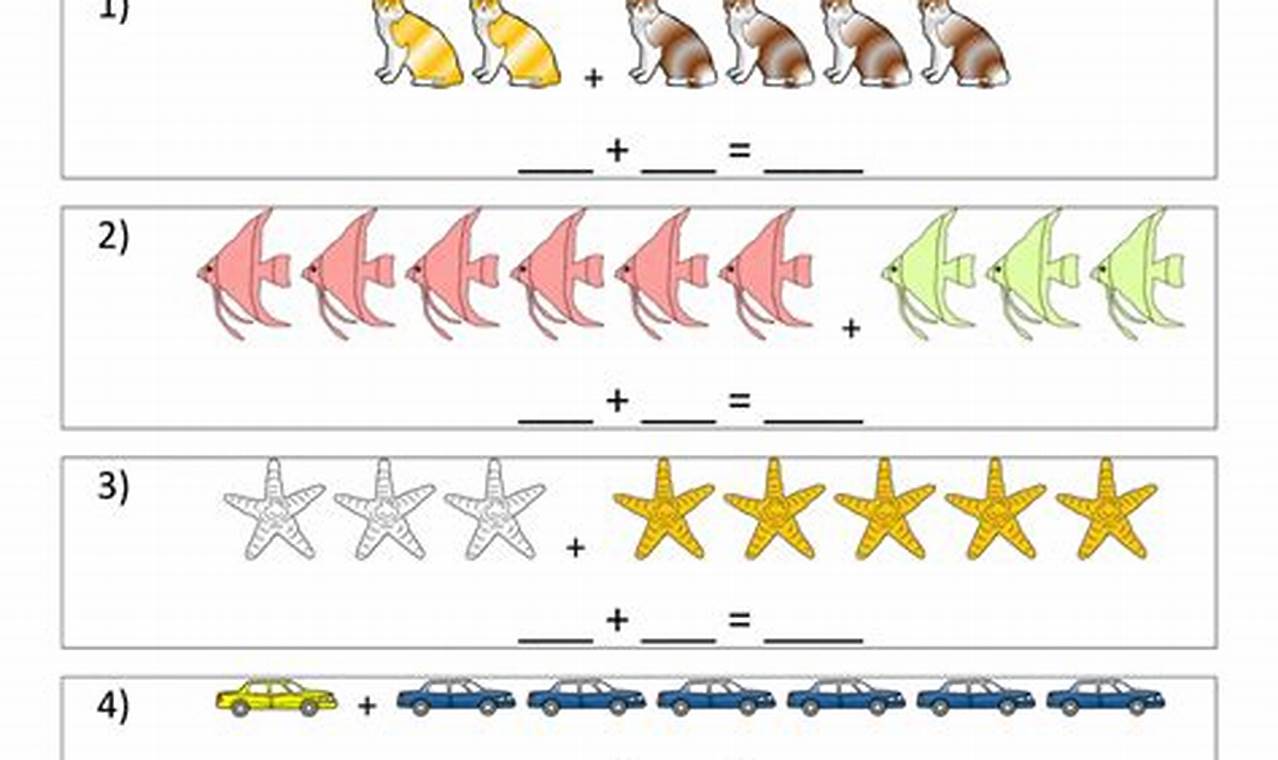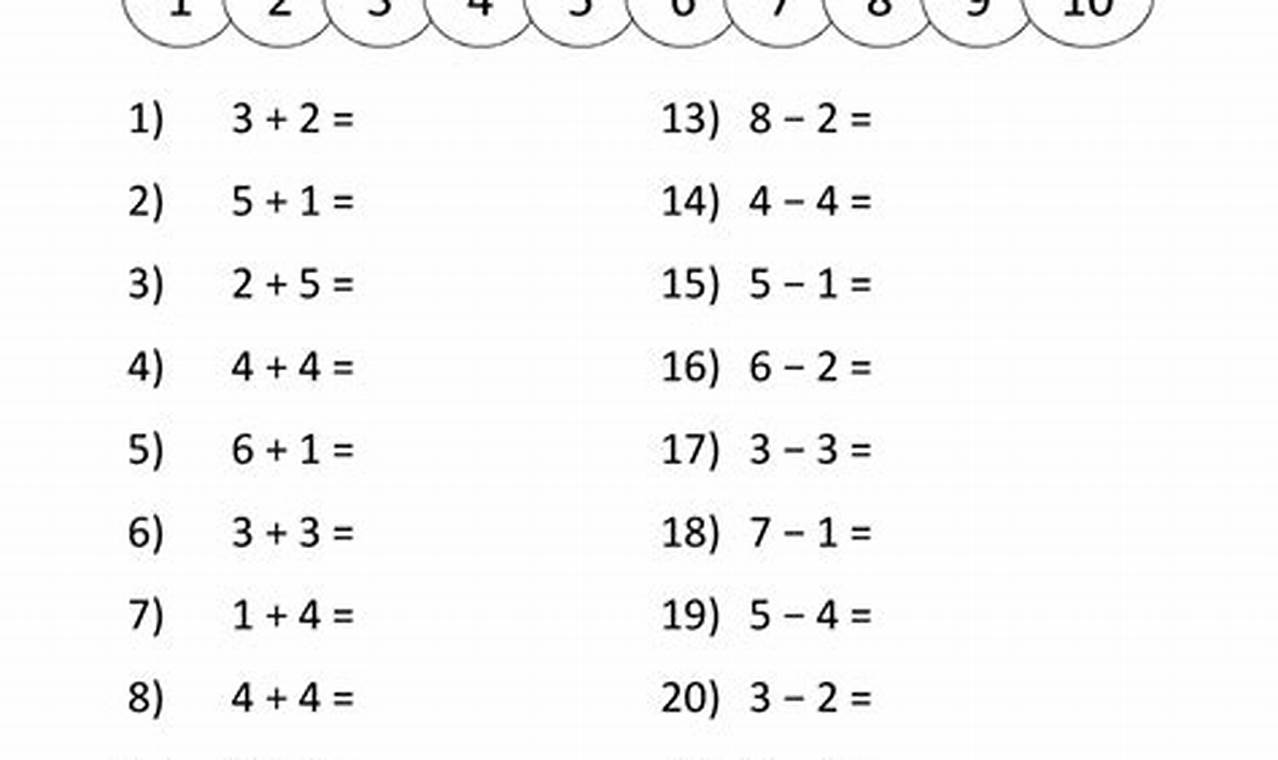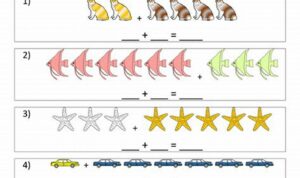An addition and subtraction worksheet is a learning tool used to teach basic arithmetic operations to young students. It typically consists of a series of problems that require the student to add or subtract numbers, often within a specific range. For example, a worksheet might ask the student to add the numbers 12 and 15 or subtract 7 from 20. Worksheets can be used for individual practice, homework assignments, or as part of a larger lesson plan. They can be tailored to the specific needs of the student, with varying levels of difficulty and complexity.
Addition and subtraction worksheets offer several benefits for students. They help to develop number sense, which is the ability to understand and manipulate numbers. They also improve problem-solving skills and logical thinking. Worksheets can be used to identify areas where students need additional support and to track their progress over time. By providing students with opportunities to practice these basic operations, worksheets can help to build a strong foundation for future math learning.
Addition and subtraction worksheets have been used in schools for centuries. They have evolved over time, with the introduction of new technologies and teaching methods. Today, worksheets are available in a variety of formats, including printable PDFs, online exercises, and interactive games. Regardless of the format, addition and subtraction worksheets remain an essential tool for teaching basic math skills to young students.
Addition and Subtraction Worksheet
Addition and subtraction worksheets are a fundamental tool for teaching basic math skills to young students. They offer several key benefits, including:
- Number sense: Worksheets help students develop number sense, which is the ability to understand and manipulate numbers.
- Problem-solving: Worksheets improve problem-solving skills and logical thinking.
- Assessment: Worksheets can be used to identify areas where students need additional support and to track their progress over time.
Addition and subtraction worksheets come in a variety of formats, including printable PDFs, online exercises, and interactive games. They can be tailored to the specific needs of the student, with varying levels of difficulty and complexity. Regardless of the format, addition and subtraction worksheets remain an essential tool for teaching basic math skills to young students.
Number sense
Number sense is a fundamental mathematical skill that involves understanding the relationships between numbers and being able to perform operations on them flexibly. It is a key component of mathematical fluency, which is the ability to perform mathematical operations efficiently and accurately. Addition and subtraction worksheets play a vital role in developing number sense by providing students with opportunities to practice these operations and see how they work.
For example, a worksheet might ask students to add or subtract two-digit numbers, such as 34 + 25 or 47 – 19. By working through these problems, students learn how to break down numbers into smaller parts, regroup numbers when necessary, and perform the operations correctly. They also develop an understanding of the relationships between numbers, such as the fact that 10 + 10 is the same as 20, and that subtracting a smaller number from a larger number results in a smaller number.
Number sense is essential for success in mathematics. It allows students to solve problems, make estimates, and understand the world around them. Addition and subtraction worksheets are a valuable tool for developing this critical skill.
FAQs on Addition and Subtraction Worksheets
Addition and subtraction worksheets are a staple of early math education. They provide students with practice in basic arithmetic operations and help them develop number sense. However, some parents and educators have questions about how to use these worksheets effectively.
Question 1: How often should students use addition and subtraction worksheets?
Answer: There is no one-size-fits-all answer to this question. Some students may benefit from daily practice, while others may only need to use worksheets a few times per week. It is important to gauge each student’s individual needs and adjust the frequency of worksheet use accordingly.
Question 2: What is the best way to help students who struggle with addition and subtraction?
Answer: There are a number of strategies that can be helpful for students who struggle with addition and subtraction. These include using manipulatives, such as blocks or counters, to represent numbers; breaking down problems into smaller steps; and providing students with extra practice. It is also important to be patient and encouraging, and to avoid making students feel frustrated or ashamed.
Question 3: Are there any alternatives to traditional addition and subtraction worksheets?
Answer: Yes, there are a number of alternative activities that can help students practice addition and subtraction, such as playing games, solving puzzles, and using online math manipulatives. These activities can be more engaging and motivating for students, and they can also help them to develop a deeper understanding of math concepts.
Question 4: How can I make addition and subtraction worksheets more challenging for advanced students?
Answer: There are a number of ways to make addition and subtraction worksheets more challenging for advanced students. These include using larger numbers, adding or subtracting multiple-digit numbers, and including word problems. You can also challenge students to solve problems mentally, without using a calculator.
Question 5: What are some common mistakes that students make on addition and subtraction worksheets?
Answer: Some common mistakes that students make on addition and subtraction worksheets include forgetting to carry or borrow, misaligning numbers, and making simple calculation errors. It is important to review students’ work carefully and provide them with feedback on their mistakes so that they can learn from them.
Question 6: How can I use addition and subtraction worksheets to assess student learning?
Answer: Addition and subtraction worksheets can be used to assess student learning in a number of ways. For example, you can use them to assess students’ basic arithmetic skills, their ability to solve word problems, and their ability to apply math concepts to real-world situations.
Summary of key takeaways or final thought:
Addition and subtraction worksheets are a valuable tool for teaching basic math skills. They can be used to develop number sense, improve problem-solving skills, and assess student learning. By using worksheets effectively, you can help your students succeed in math.
Transition to the next article section:
In the next section, we will discuss how to use addition and subtraction worksheets to teach specific math concepts.
Tips for Using Addition and Subtraction Worksheets
Addition and subtraction worksheets are a valuable tool for teaching basic math skills. By using these worksheets effectively, you can help your students succeed in math. Here are five tips for using addition and subtraction worksheets:
Tip 1: Start with the basics. Before giving students worksheets with complex problems, make sure they have a solid understanding of the basic operations. This means being able to add and subtract single-digit numbers, as well as being able to regroup when necessary.Tip 2: Use manipulatives. Manipulatives are objects that students can use to represent numbers and operations. This can help them to visualize the problems and make sense of the math. Some common manipulatives include blocks, counters, and beans.Tip 3: Break down problems into smaller steps. If students are struggling with a particular problem, break it down into smaller steps. This will make the problem seem less daunting and more manageable.Tip 4: Provide students with plenty of practice. The more practice students have, the more fluent they will become at addition and subtraction. Make sure to give students plenty of opportunities to practice these skills, both in class and at home.Tip 5: Use a variety of worksheets. There are many different types of addition and subtraction worksheets available. Some worksheets focus on basic operations, while others include word problems or more challenging problems. By using a variety of worksheets, you can keep students engaged and motivated.
Summary of key takeaways or benefits:
By following these tips, you can help your students get the most out of addition and subtraction worksheets. These worksheets can be a valuable tool for teaching basic math skills and helping students to succeed in math.
Transition to the article’s conclusion:
Addition and subtraction worksheets are an essential tool for teaching basic math skills. By using these worksheets effectively, you can help your students develop a strong foundation in math and prepare them for future success.
Conclusion on Addition and Subtraction Worksheets
Addition and subtraction worksheets are an essential tool for teaching basic math skills. They provide students with practice in these operations and help them develop number sense. By using addition and subtraction worksheets effectively, teachers can help their students succeed in math.
This article has explored the benefits of addition and subtraction worksheets, discussed how to use them effectively, and provided tips for using them with different types of learners. We have also seen how addition and subtraction worksheets can be used to assess student learning and prepare them for future success in math.
In conclusion, addition and subtraction worksheets are a valuable tool for teaching basic math skills. By using these worksheets effectively, teachers can help their students develop a strong foundation in math and prepare them for future success.


